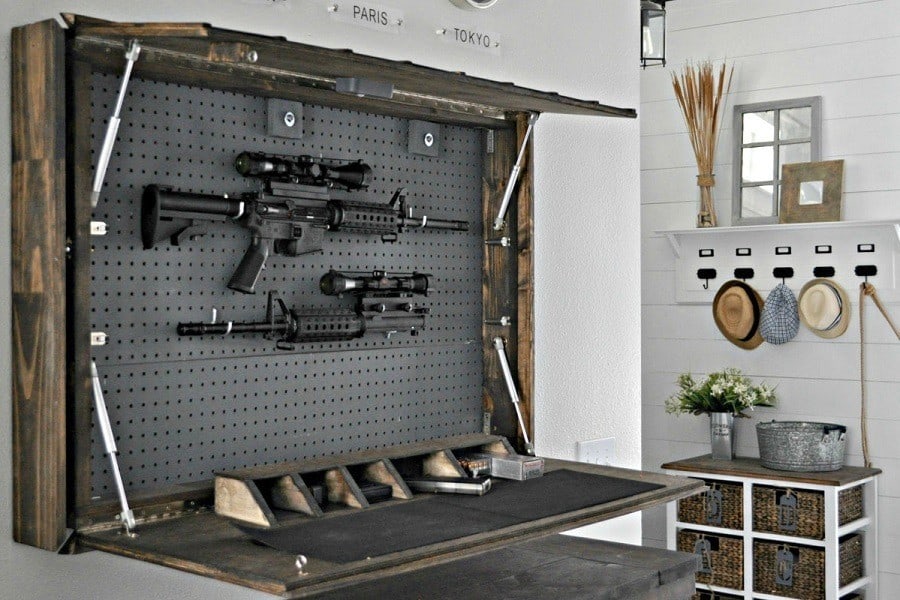
Building an In-Wall Gun Cabinet with Concealed Access Panels
Securing firearms within the home is paramount for safety and peace of mind. An in-wall gun cabinet with concealed access panels offers a discreet and robust solution for storing firearms, safeguarding them from unauthorized access while seamlessly integrating them into your home decor. This guide outlines the steps involved in constructing such a secure storage solution.
Planning and Design
1. Determine Location and Size
Choose a suitable location within your wall that is both accessible and discreet. Consider factors like proximity to electrical outlets, plumbing, and structural support beams. Measure the desired dimensions of the cabinet, ensuring it fits within the available space.
2. Access Panel Placement
Designate the location(s) for the concealed access panels. Opt for inconspicuous areas like behind artwork, mirrors, or within cabinets. Ensure the panels can be easily accessed while remaining visually concealed.
3. Material Selection
Select sturdy materials for the cabinet frame and doors. Plywood, MDF, or solid wood offer excellent durability and stability. Choose a material that complements the surrounding wall and seamlessly blends in with your home decor.
4. Security Features
Integrate robust security features for enhanced protection. These may include:
- Heavy-duty hinges and latches
- Reinforced door frames
- Locking mechanisms with tamper-resistant features
- Motion sensors or alarms for added security
Construction
1. Framing and Support
Construct the cabinet frame using the chosen materials. Create a sturdy and stable structure capable of supporting the weight of the firearms and any additional storage components. Ensure that the frame is properly anchored to the wall studs for stability.
2. Interior Shelves and Components
Design the interior layout to accommodate your specific firearm needs. Install shelves, dividers, and other storage components to maximize space and organize your firearms effectively. Consider incorporating features like adjustable shelves or specialized firearm racks for safe and secure storage.
3. Access Panel Installation
Cut openings for the access panels in the wall and cabinet frame. Install sturdy frames around each opening. Securely mount the access panels using concealed hinges and magnetic latches for a seamless and discreet look.
4. Finishing and Refinement
Apply finishing touches to create a seamless integration with the existing wall. Paint, stain, or wallpaper the cabinet to match the surrounding decor. Consider adding decorative elements like moldings or trim to further enhance the visual appeal.
Concealed Access Panel Design
1. Flush Mount Panels
Create a flush mount panel that seamlessly blends into the wall. Utilize the same material and finish as the surrounding wall to create a completely invisible access point.
2. Decorative Covers
Cover the access panel with a decorative element such as artwork, a mirror, or a shelf. This approach disguises the access point while adding visual interest to your home decor. Use secure mounting methods for the cover to prevent accidental removal.
3. Cabinet-Integrated Panels
Integrate the access panels into existing cabinets or shelving units. Create a hidden door within the cabinet that opens to reveal the gun cabinet. This approach provides additional storage space while concealing the gun cabinet.
Security Considerations
1. Locking Mechanisms
Utilize high-quality locking mechanisms for the access panels and the gun cabinet itself. Consider using key locks, combination locks, or biometric locks for enhanced security. Select locking mechanisms with tamper-resistant features and high-security ratings.
2. Access Control
Restrict access to the gun cabinet to authorized individuals. Limit the number of keys or combination codes and store them securely. Encourage safe handling practices and educate family members about the importance of secure storage.
3. Monitoring and Alarms
Consider integrating motion sensors or alarms with the gun cabinet to provide further protection. These systems can alert you to any unauthorized access attempt.
Safety and Maintenance
1. Safe Handling Practices
Always practice safe firearm handling procedures, including unloading, securing, and storing firearms appropriately. Educate yourself on proper firearm safety and handling techniques.
2. Regular Inspection
Periodically inspect the gun cabinet and access panels for wear and tear, ensuring all components are functioning properly. Lubricate hinges and latches to maintain smooth operation and prevent malfunctions.
3. Environmental Conditions
Store firearms in a dry environment to prevent corrosion and damage. Avoid storing firearms in areas exposed to excessive humidity or extreme temperatures. Consider using a dehumidifier or desiccant packets to maintain optimal storage conditions.
Legal Considerations
Consult local and state laws regarding firearm storage requirements. Ensure your gun cabinet construction and security measures comply with all applicable regulations. It is crucial to understand and adhere to local laws related to firearm storage, ensuring safe and legal firearm ownership.
Conclusion
Building an in-wall gun cabinet with concealed access panels provides a discreet and secure solution for firearm storage. By following these guidelines, you can create a robust and aesthetically pleasing storage system that safeguards your firearms while maintaining the integrity of your home decor. Remember to prioritize safety, security, and compliance with all relevant laws and regulations. Proper planning, meticulous construction, and ongoing maintenance will ensure your firearms are stored securely and responsibly within your home.

0 comments:
Post a Comment